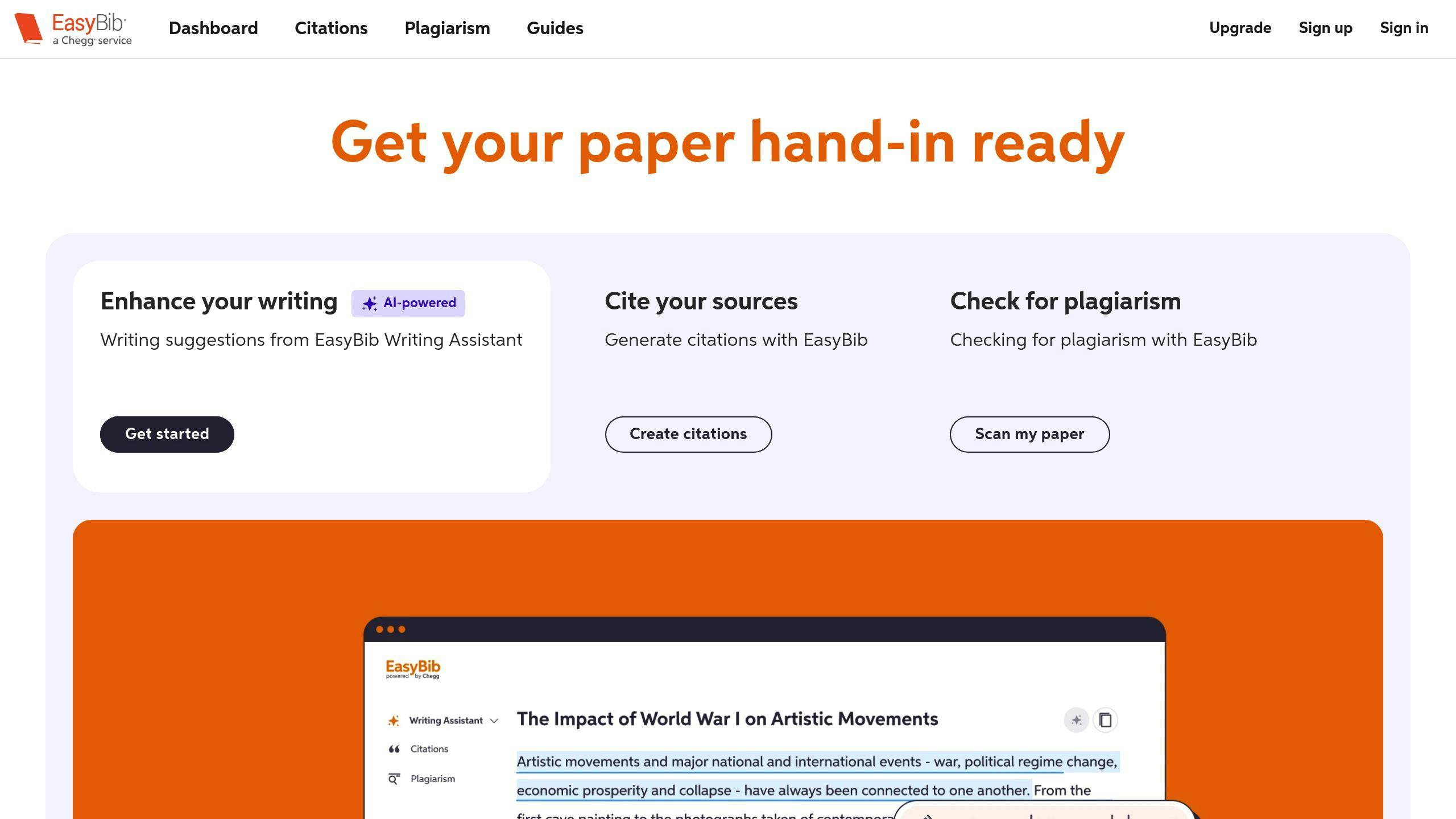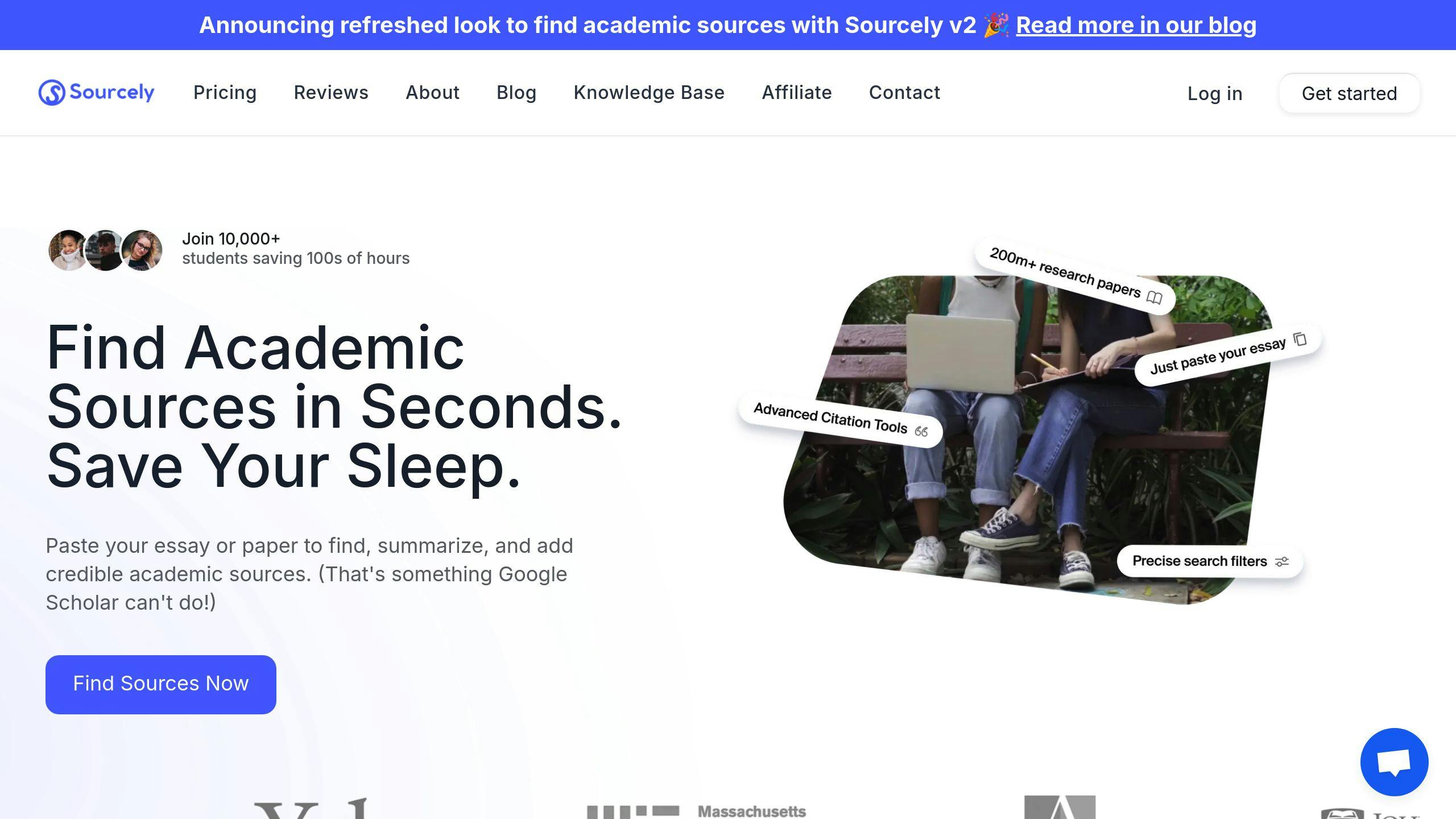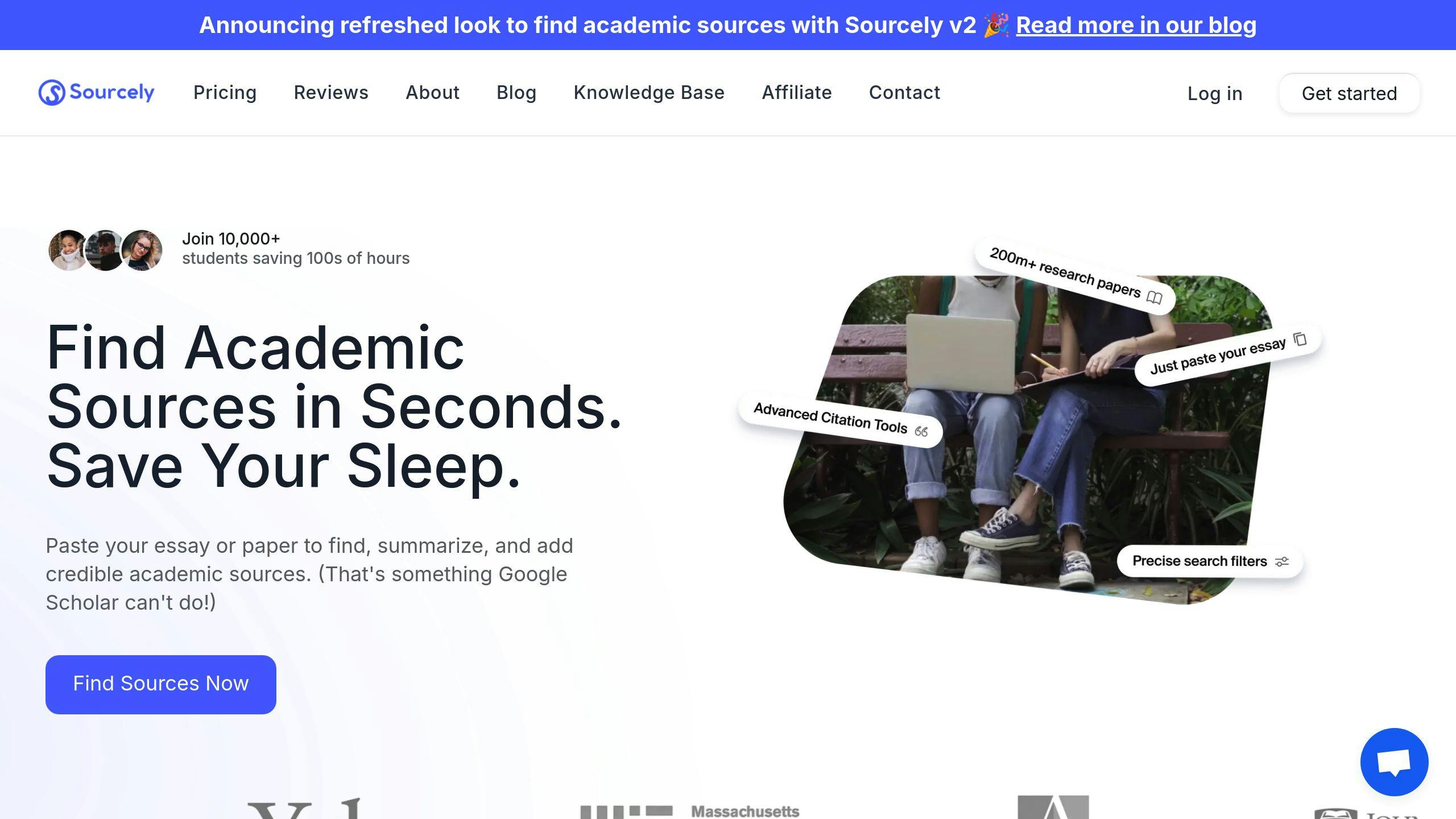
EasyBib for MLA Citations: A Step-by-Step Tutorial
Want to create MLA citations effortlessly? EasyBib simplifies the process by automating the formatting for in-text citations and Works Cited entries. Whether you're citing books, websites, or journal articles, EasyBib ensures your references follow MLA guidelines.
Key Features of EasyBib:

- Automatic Citation Generator: Enter a book title, URL, or DOI, and EasyBib fills in the details.
- Manual Entry for Rare Sources: Add uncommon or unpublished works manually.
- Export Options: Copy citations directly or export to Word/Google Docs.
- Multiple Source Types: Supports books, online articles, multimedia, and more.
Quick Steps:
- Select "MLA" style on EasyBib.
- Add source details (automatic or manual).
- Review and export your citations.
For advanced research needs, consider tools like Sourcely, which offers AI-powered source suggestions and essay analysis. Below is a quick comparison of EasyBib and Sourcely to help you choose the right tool.
Quick Comparison:
| Feature | EasyBib | Sourcely |
|---|---|---|
| Citation Styles | MLA, APA, Chicago, etc. | Multiple formats, including MLA |
| Source Discovery | Manual entry only | AI-powered suggestions |
| Database Access | Limited free sources | Access to millions of sources |
| Essay Analysis | Not available | Scans essays for missing citations |
| Free Tier Features | Basic citation tools | Core tools with source organization |
Use EasyBib for quick MLA citations or Sourcely for managing complex research projects. Both tools ensure your citations are accurate and formatted correctly.
Overview of MLA Citations
What Are MLA Citations?
MLA citations are a standardized way to credit sources in academic writing. They help maintain academic honesty, prevent plagiarism, and demonstrate the credibility of your research. Created by the Modern Language Association, this format makes it easier for readers to trace the sources you’ve used. MLA citations include two key parts: in-text citations within your paper and full citations listed in the Works Cited section [2].
Main Parts of an MLA Citation
An MLA citation consists of several core elements arranged in a specific order:
| Component | Description | Example |
|---|---|---|
| Author | Last name, First name | Smith, John |
| Title | Name of the work | The Digital Age |
| Container | Larger work containing the source | Journal of Modern Literature |
| Publisher | Organization responsible for publication | Oxford University Press |
| Publication Date | When the work was published | 2024 |
| Location | Page numbers or URL | pp. 125-140 |
These elements make it easier for readers to find your sources. For example, books require details like the author’s name, title, publisher, and publication date. Print materials often include page numbers, while online sources need URLs or DOIs. If a source has three or more authors, use "et al." after the first author’s name [3].
The MLA Handbook offers detailed instructions for citing a wide range of materials, from traditional books to digital content [4]. Familiarizing yourself with these components is especially helpful when using citation tools like EasyBib. This knowledge ensures you can input the right details and create accurate citations.
EasyBib Works Cited Page for MLA Citation Format Tutorial
Step-by-Step Guide to Using EasyBib for MLA Citations
This guide walks you through how to use EasyBib to simplify creating MLA citations, making the process quicker and more manageable.
Getting Started with EasyBib and Selecting MLA Style
Head to the EasyBib website and locate the citation style selector at the top of the page. Click on "MLA" to ensure your citations match the Modern Language Association format [3]. While creating an account isn’t required, signing up allows you to save your citations, organize them into folders, and access them across multiple assignments.
The interface highlights different source types like books, websites, and journals, each with forms designed to meet MLA standards. Once you’ve selected MLA style, you’re ready to input your source details.
Adding Source Information
EasyBib offers three main ways to add source details:
| Citation Method | Best For | Process |
|---|---|---|
| Automatic Search | Books, articles, websites with DOIs | Enter ISBN, title, or URL to auto-fill details |
| Manual Entry | Unpublished works, rare sources | Manually input details for uncommon sources |
| Database Citations | Academic journals, research papers | Use a form with database-specific fields |
For manual entries, double-check that all required fields are complete to avoid errors. For books, include the author’s last name, first name, the book title in italics, the publisher, and the publication year. For online sources, make sure to add the URL and the access date [3].
Creating and Exporting Citations
EasyBib automatically generates both in-text citations and full reference entries. For in-text citations, it follows the MLA format: the author’s last name and page number (e.g., Smith 13) [2]. If the author’s name is mentioned in your text, only include the page number in parentheses.
To export your citations:
- Review the generated citation for any errors or missing details.
- Export in your preferred format, such as Word or Google Docs, or copy and paste directly into your bibliography.
sbb-itb-f7d34da
Solving Common MLA Citation Problems
Even with EasyBib's automated tools, some citation scenarios need extra attention to ensure they’re done correctly.
Citing Multiple Authors
Different author combinations require specific citation formats. Here's how they break down:
| Number of Authors | Citation Format | Example |
|---|---|---|
| Two Authors | Last, First, and First Last | Johnson, David, and Valerie Smith |
| Three or More | First Author's Last, First, et al. | Johnson, David, et al. |
| Organizational | Organization Name | American Psychological Association |
For in-text citations, list both last names for two authors (e.g., Johnson and Smith). For three or more, use the first author's last name followed by et al. (e.g., Johnson et al.).
Although citing multiple authors is usually simple, digital sources often demand extra precision.
Citing E-Books, Online Articles, and Other Sources
Digital and multimedia sources come with their own set of challenges. EasyBib has specialized fields to help you cite these accurately.
For e-books, include the following:
- Author's name
- Book title (italicized)
- Publication date
- Platform or database name and URL (drop the 'https://')
For online articles, EasyBib asks for:
- Author's name
- Article title (in quotation marks)
- Website name (italicized)
- Publication date
- URL
- Access date (helpful for undated sources)
When citing videos, podcasts, or other multimedia, select the appropriate source type in EasyBib. It will guide you to input all the required details.
To ensure your digital citations are accurate:
- Add access dates for sources with no clear publication date
- Use DOIs for stable links whenever possible; if none are available, double-check that URLs are up-to-date
EasyBib’s formatting tools automatically handle punctuation and capitalization, making it easier to avoid common mistakes.
Using Sourcely as Another Option

While EasyBib focuses on simplifying citation formatting, Sourcely steps in with tools designed for more detailed research tasks. This platform not only creates MLA citations but also helps users find and organize academic sources using AI.
Sourcely can scan entire essays to spot missing citations and recommend relevant sources. It also provides access to extensive academic databases, making it easier for researchers to stay organized and meet citation standards efficiently.
EasyBib vs. Sourcely: Feature Comparison

Here’s a side-by-side look at what EasyBib and Sourcely bring to the table:
| Feature | EasyBib | Sourcely |
|---|---|---|
| Citation Styles | MLA, APA, Chicago, and more | Multiple formats, including MLA |
| Source Discovery | Manual entry only | AI-powered source suggestions |
| Database Access | Limited free sources | Access to millions of academic sources |
| PDF Access | Not available | Free PDF downloads |
| Essay Analysis | Not available | Scans essays to suggest sources |
| Basic Features | Free | Free tier with core tools |
| Advanced Features | Paid subscription required | Premium plans for added capabilities |
| Platform Integration | Word and Google Docs | Integrates with academic platforms |
Sourcely also offers summaries of academic papers to help you evaluate their relevance before citing. Additionally, you can sort sources by relevance, date, or type, making it easier to manage large research projects.
If you’re looking for quick MLA citations, EasyBib is a solid choice. But if your research involves managing numerous sources and you need extra tools like AI-powered suggestions, Sourcely might be a better fit. Pick the tool that aligns with your workflow and ensures accurate citations.
Conclusion
This guide highlights how EasyBib turns the often-complex task of creating MLA citations into a simple, manageable process. Its user-friendly design allows for quick and accurate citation generation while upholding academic standards.
Citation tools like EasyBib provide more than just convenience. They streamline formatting for a wide range of sources - books, articles, and digital media - while ensuring users adhere to academic guidelines. Properly formatted citations are crucial for building credibility in research and avoiding plagiarism [2].
With its step-by-step guidance, EasyBib ensures MLA formatting stays consistent, making it a reliable tool for both new and experienced researchers [1]. Its features address diverse citation needs, giving users the confidence to meet academic expectations.
Using EasyBib goes beyond formatting - it reinforces the importance of proper attribution in academic work. While the platform handles the technical details, it helps users gain a stronger understanding of citation practices, which is valuable across various fields and writing projects.
FAQs
How to cite in MLA using EasyBib?
To create MLA citations with EasyBib, you'll need these key details:
| Required Information | Description |
|---|---|
| Author | The name of the author |
| Title | The title of the work |
| Website Title | The name of the hosting website |
| Publisher | If different from the website title |
| Publication Date | The date the work was published |
| URL | The web address of the source |
EasyBib automatically generates citations following MLA 9th edition standards [4]. Whether you're citing e-books, online articles, academic journals, or even social media posts, the platform ensures proper formatting for a wide range of source types.
Pro Tips for Using EasyBib:
- Always double-check your citations for accuracy.
- Use the preview feature to review your citations before submission.
- Verify all source details to ensure they meet MLA guidelines [3].
EasyBib follows the latest MLA rules, such as italicizing container titles and placing article titles in quotation marks [1]. Its automated tools make it easier to tackle citation tasks while keeping your formatting consistent and aligned with academic standards.